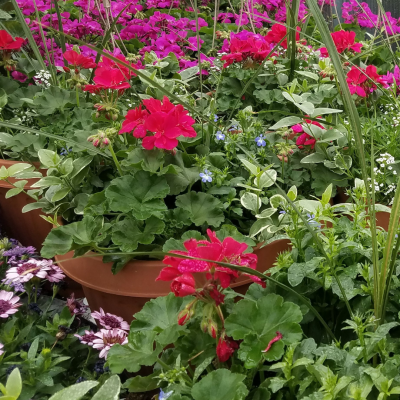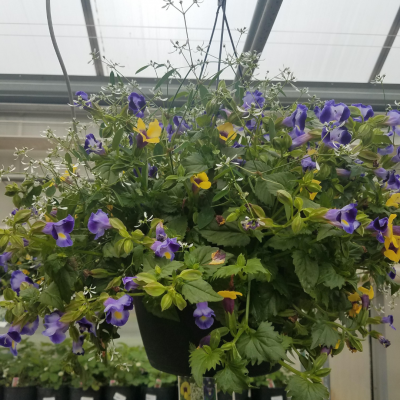By: Heather Zidack, UConn Home & Garden Education Center

Hanging baskets, planter boxes and perennial gardens that are bursting with color are seldom planted in spring and left untouched until autumn. Deadheading, pruning, trimming and pinching are all techniques that gardeners can use to get that perfect look all season long. While it may be intimidating, this simple task can result in a huge visual impact with only a little effort. Through a series of pruning techniques, we manipulate our perennials and annuals to give us the most beauty we can get out of them in such a short season. It is important to recognize that cutting healthy flowers or shoots can help plants in the long term – no matter how much it may pain us as gardeners to do so.
Deadheading is a widespread practice where gardeners remove flowers that have gone by. One of the first things to become aware of is the difference between a bud and a spent bloom on the plant you are working on. Many gardeners will snip petunia buds, mistaking them for spent flowers. It is important to be vigilant with these cuts. Remember that your plant's goal is to reproduce, and they use flowers to do so. By removing the flowers, you are stopping the plant from producing seed and encouraging it to restart the cycle – meaning more flowers for you!
Some gardeners will select “self-cleaning” varieties of annuals that will shed their flowers without the need to deadhead all summer long. In general, these may not produce seed; therefore can easily restart the process themselves.
The whole practice of deadheading, pinching and trimming herbaceous plants can be boiled down to redirecting the plants energy into different purposes. Where deadheading helps to clean spent flowers, pinching will remove new buds before they bloom. If you want to encourage beautiful single stem cut flowers, for example, you may decide to pinch lateral (side) flower buds to force the plant to put all its energy into a single bloom at the top. Alternatively, pinching the terminal (top) bud will give you many smaller flowers on one stem, creating a fuller appearance.
This same principle applies to pinching shoots of herbaceous plants to make them fill out more. Cutting further down a stem will again remove that terminal bud and cause the plant to focus its energy on new shoots that come from nodes further down the stem. Think of how full your basil plants flush out when you harvest fresh herbs.

Often, gardeners will notice that in mid to late summer their hanging baskets will start to look “tired.” They may notice prolific flowering on the ends that hang down, but often see that the center of the basket is not as full or may even be dying out. The first thing to check for is to make sure that you are watering them regularly. Because hanging baskets are suspended in the air and uninsulated, they will dry out faster. When you are trimming herbaceous plants for growth you can take one third of the plant volume away at a time, safely. Think about it as playing hair stylist! Cut back one third of the longest growth at the ends, and watch new growth come from the roots. It may also help your hanging baskets to remove any branches that have been shaded or dried out in the interest of “lightening” the growth that is hanging down. Again, you may lose flowers for a week or two – but the result down the road will be beautiful!
For perennial gardens, June is a wonderful time to do some pruning as well. Cutting back early flowering perennials can encourage a second flush of flowering in some species. This works exceptionally well for plants like Salvia, Nepeta, and Lavender. Deadheading throughout the season will help plants like roses and Echinacea continuously flower. And pinching can help perennial mums form their shape for the fall.
Summer is a stressful time for plants! Disease, pests, and extreme weather can all contribute to a stressful environment. Our New England summers can promote these pressures with high heat and humidity levels. During these times, pay careful attention to your watering habits and adjust, as necessary. In times of drought or excessive heat, plants will use water faster for hydration and cooling, just like we do. Being aware of this can help you know when to check for water and help you be more diligent with your watering practices. Using a balanced, water-soluble fertilizer can also promote plant health and reduce stress in perennials and annuals. This is why it is great to fertilize after pruning and deadheading. If you need more information on trimming, watering, fertilizing, or any other gardening questions, feel free to contact us, toll-free, at the UConn Home & Garden Education Center at (877) 486-6271, visit our website at www.homegarden.cahnr.uconn.edu